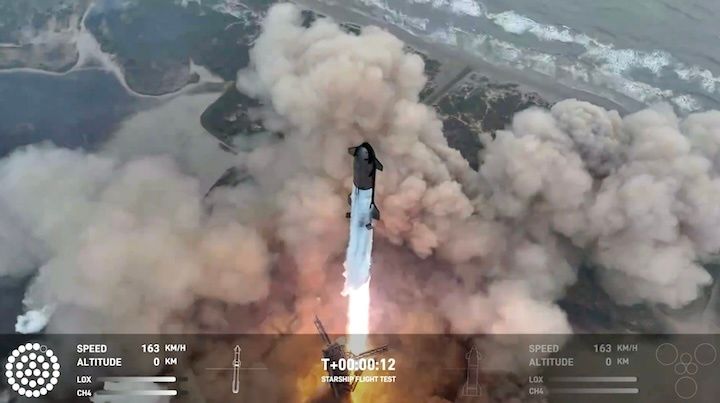1.09.2024
Observations highlight threats to GPS and similar systems from natural as well as human-caused disturbances.

The huge explosions that destroyed SpaceX’s Starship mega-rocket last year also blew one of the biggest ‘holes’ ever detected in the ionosphere, a layer of thin air in the upper atmosphere. The hole stretched for thousands of kilometres and persisted for nearly an hour, a study found1.
Study co-author Yury Yasyukevich, an atmospheric physicist at the Institute of Solar‐Terrestrial Physics in Irkutsk, Russia, says that the extent of the disturbance took his team by surprise: “It means we don’t understand processes which take place in the atmosphere.” He adds that such phenomena could have implications for future autonomous vehicles that might require precision satellite navigation. The results were published on 26 August in Geophysical Research Letters.
Record-setting rocket
On 18 November last year, SpaceX launched its Starship rocket — the biggest and most powerful rocket ever built — from a launchpad in Boca Chica, Texas. Starship’s first stage is designed to return safely to the surface for reuse but blew up shortly after separating from the upper stage, roughly 90 kilometres above the Gulf of Mexico. Minutes later, the self-destruction mechanism on the upper stage fired, triggering a second explosion at an altitude of around 150 kilometres.
Yasyukevich and his collaborators were curious to find out how such massive explosions could affect the ionosphere, a zone of the atmosphere extending from about 50 to 1,000 kilometres above sea level in which the Sun’s radiation can strip some air molecules of their electrons. The result is that a small percentage of the ionosphere’s mass consists of electrons and positively charged ions, while the rest of the air molecules remain neutral. The exact ratio of ionized to neutral molecules varies with factors such as altitude and latitude.
That ratio affects the speed at which the radio waves beamed down by global navigation satellites propagate in the ionosphere. Crucially, changes in the ratio have different effects on different radio frequencies. This enables researchers to measure the amount of ionization in real time by comparing the speeds of radio waves of two different frequencies, Yasyukevich explains.
Such data have been used for decades to reveal how events ranging from earthquakes to underground nuclear tests affect the ionosphere. These natural and human-caused disruptions can temporarily nullify the effects of solar radiation by causing electrons and ions to recombine into neutral molecules.
Neutralizing the air
The team examined publicly available data from more than 2,500 ground stations across North America and the Caribbean that receive satellite navigation signals. They found that the Starship explosions produced shock waves that travelled faster than the speed of sound, turning the ionosphere into a region of neutral atmosphere — a “hole” — for nearly an hour over a region stretching from Mexico’s Yucatán peninsula to the southeastern United States. Rocket exhaust can trigger chemical reactions that produce temporary holes in the ionosphere even in the absence of an explosion, but in this case the shockwaves themselves had by far the larger effect, Yasyukevich says.
“I was impressed by this case study,” says Kosuke Heki, a geophysicist at Hokkaido University in Sapporo, Japan, who was an open reviewer for the paper. But he thinks that the chemical effects of the large conflagration were the dominant cause of the hole.
The hole was not quite as large as the one caused by the eruption of a Tongan volcano in early 2022, Heki says, but it beat the one produced by the historic meteor that fell near Chelyabinsk, Russia, in 2013 — the biggest in a century.
Ionospheric disturbances can affect not only satellite navigation but also communications and radio astronomy. As launch frequencies increase, these effects might become more of a problem.
Quelle: nature
